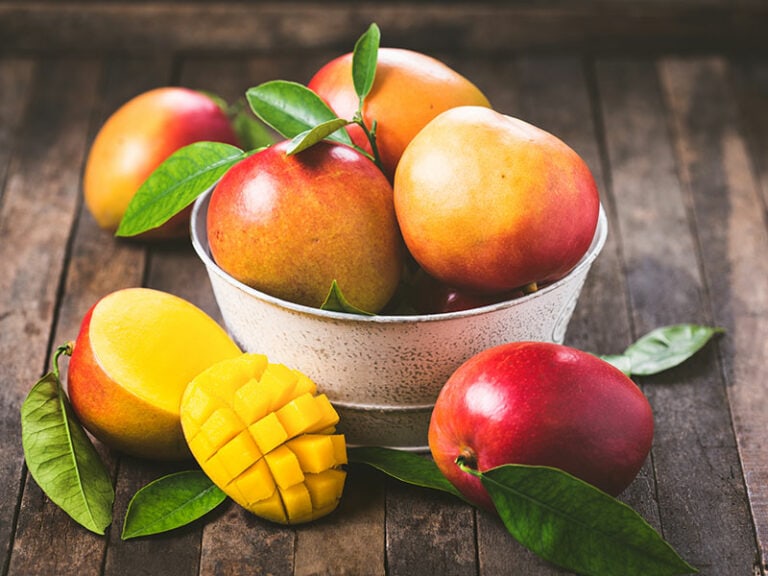Are you wondering how to tell if a mango is bad? Luckily, in this post, I will show you some easy signs you can look for to check if your mango has gone bad or not.
It’s important to check before you eat mango, as consuming bad mangoes can lead to disastrous consequences, from stomach problems to food poisoning, along with probably ruining mango for you forever. With that in mind, let’s dive in!
Generally, these are the factors you can look for to determine whether your mango is still edible: The smell, the taste; the texture; the skin; and the mold.
But before I get started on how these manifest on bad mangoes, let me first walk you through some basic knowledge of this fruit, starting with the types of mangoes you can find and what they are supposed to look (and taste) like.
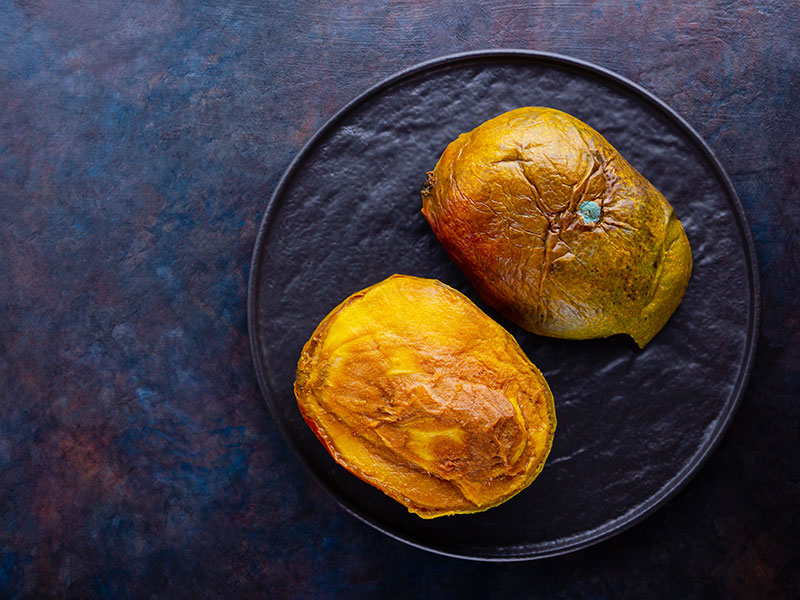
Fantastic Mangoes and How To Classify Them
Mango is a wonderful tropical fruit with a heavenly taste and incredible nutritional value. However, many people have difficulties navigating the world of mango, as they are unfamiliar with the fruit.
And that’s why I’m here to help! First, let’s look at the general descriptions of some of the most popular types of mango in America.
Types Of Mango
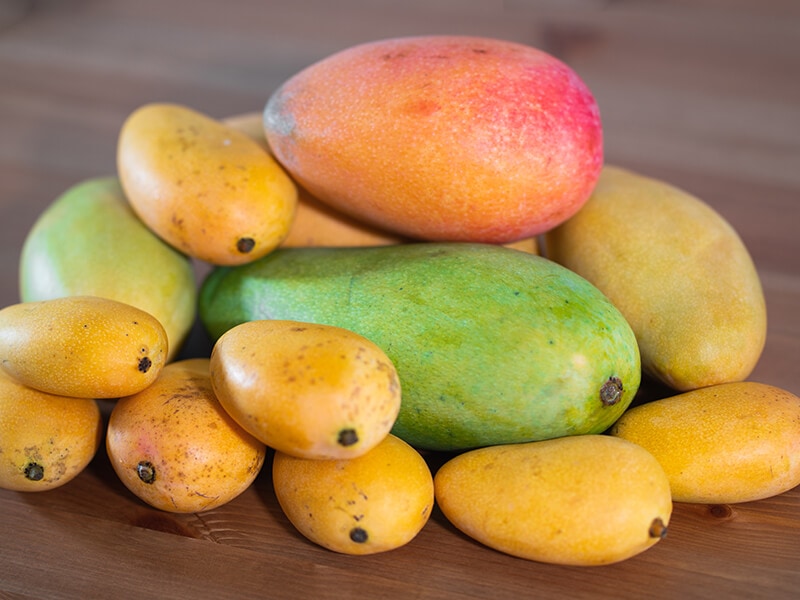
Mango is now grown globally with a wide range of tastes, colors, and shapes. Many might struggle to pick out the type of mango that suits their taste, as there are just so many of them.
There are hundreds of varieties of mango around the world, but only a few dozen are available in America. Among them, there are six types of mango that are most likely to be found at department stores all at different times of the year. (1)
How Long Does Mango Usually Last?
Preserving tropical fruits can be hard, and mistakes can easily be made. Some even may say, “It’s like they ripen and go bad in a second!”. So the question here is, how long should we expect mango to last?
The shelf life of mango depends on many factors, including ripeness, storage temperature, and the state it was stored in. The general rule of thumb is that putting mango in the fridge or freezer will make it last longer, and a whole mango lasts longer than sliced mango.
At room temperature, an unripe mango will last for about 1 – 7 days before it fully ripens, depending on how green and firm it was when you bought it. From then on, it will take 1 to 3 days before going bad.
Meanwhile, if you store it in the fridge, a whole ripe mango would last about 5 – 7 days. The same mango, when cut would take about 3 – 4 days, as the exposure surface is greater.
It’s also important to note that you shouldn’t put unripe mango in the freezer or fridge, as this will deter the ripening process and possibly damage the mango.
In this table, I will lay out the estimated shelf life of mango until it fully ripens. However, keep in mind that these numbers are just estimates, so you should check your mango frequently lest anything goes amiss.
How To Tell If Mango Is Edible
Mango is a tricky fruit variety (type of fruit), and it’s sometimes hard to tell if your mango is ready for consumption or not, as the signs vary from type to type. However, there are some foolproof signs that you can always check.
The Smell
Ripened mangoes usually have a rich, aromatic smell that screams delicious in its wake. You can check by giving it a whiff near the stem, if your mango smells like sugar and sweet, then it’s good to go. (2)
Spoiled mangoes, in contrast, tend to smell sour and acidic. This is because mango is a fruit high in sugar levels, so when it goes bad, the fructose ferments and gives off an alcoholic smell.
The Taste
Generally, good mangoes taste as good as they smell. Ripe mangoes taste juice and sweet, with only a tinge of sourness, depending on the type.
Bad mangoes also taste as bad as they smell. When you take a bite of rotten mango, it usually gives a sharp and pungent flavor.
The Texture
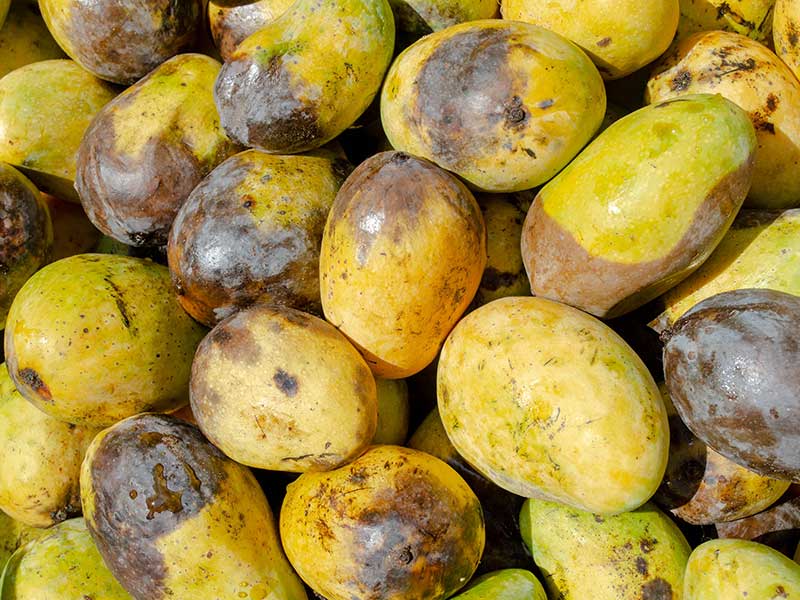
While unripe mangoes are firm and hard, ripe mangoes tend to be a little bit soft. To check, you can take your mango and give it a little squeeze. If the flesh gives a bit, your mango is ready to serve.
A mango goes bad when its skin goes too soft. Bad mangoes have mushy and overly soft flesh with big black spots inside the flesh. It also oozes liquid when you apply a bit too much force. When your mango has reached this state, it’s high time you throw it out.
The Skin
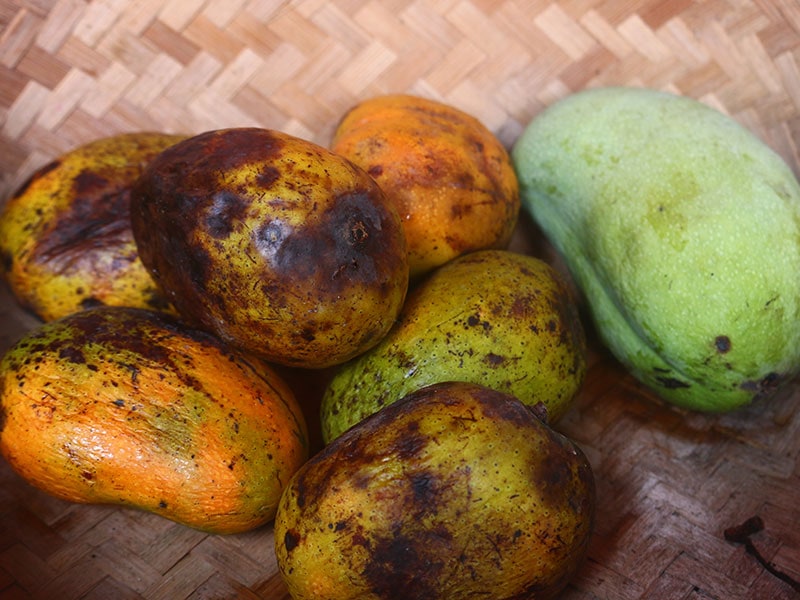
Now, some people might say all mangoes that have dark spots on their skin are bad, but that’s not necessarily the case. In some cases, those spots result from saps oozing from the stem into the mango’s skin and don’t affect the taste.
Generally, if there are only small black spots on the surface that don’t extend into the flesh, the mango is still safe to eat. However, when the dark spots have reached inside the flesh, it means the mango has started to rot, and you should not eat it.
Ripe mangoes can also change colors and develop some wrinkles, but this also depends on the type of mango. Should you have any doubts, refer to the table in the previous section to check.
Mold
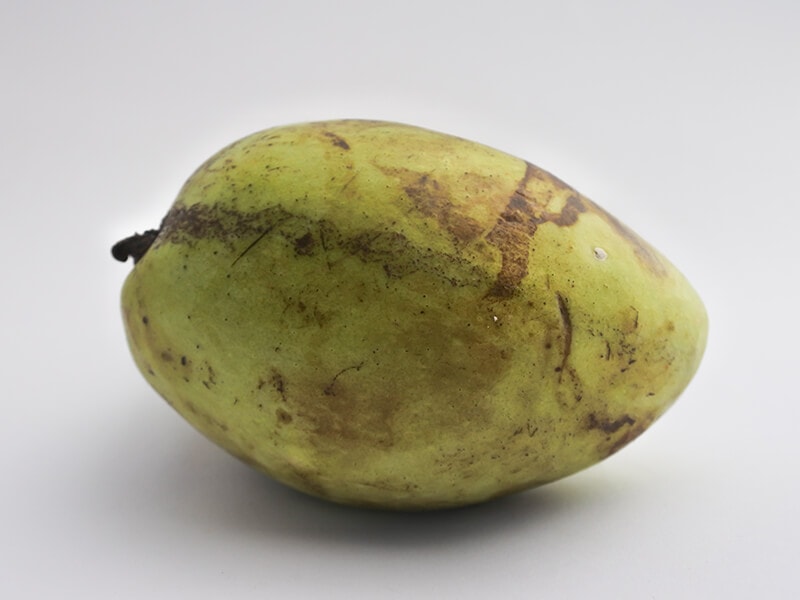
When you spot a mold patch on your mango, or on any of your food for that matter, you should throw it out immediately. And no, you can’t just scrape off the molds and then eat it either, as it is possible that the molds have penetrated into the fruit where you can’t see them.
You should throw your mango out if it shows these signs.
Is It Possible To Eat Overripe Mangoes?
While certainly past its prime, an overripe mango hasn’t necessarily gone bad. After all, the definition of “overripe” can vary from person to person – what might be ripe to one might be unripe to others.
Overripe mango tends to taste overly sweet, its texture is mushy and squashy, and is very juicy. You can tell it has yet to acquire the sour, alcoholic flavor and smell that bad mango has. It can be used to make smoothies, puree, or even chutney or mango jam.
Like with bad mango, if you don’t like a part of a mango that is overripe, you can cut it off and use the rest. Just remember, if you spot any of the rotting signs, don’t try to eat them anymore.
However, it is true that when mango is overripe, it’s not going to last much longer, and the rotting process can start any minute. So the moment you find out that your mango is overripe, eat it, and eat it quickly.
Can Eating Bad Mango Make You Sick?

So why can’t we eat bad mango again? Besides the taste, it’s not like it can do anything bad to our health, right?
Wrong. Bad mangoes can develop molds or bacteria, notably salmonella. In the best scenario, you will have a mild stomach ache should you try to consume a mango. However, you can express symptoms of food poisoning or an itchy rash, in which case you should go see a doctor.
How Can I Keep My Mango Fresh?
Nobody wants their delicious mango to go bad, but tropical fruits can be fickle. Here’s some of my suggestions to keep your mango safe + (how to store mango) and delicious.
Storing Unripe Mango
The method of storing unripe mango depends on how you plan to eat it. That said, there are a few crucial steps that you have to take with every mango that you buy. Check out my instructions below to see what they are.
Choosing The Right Mango
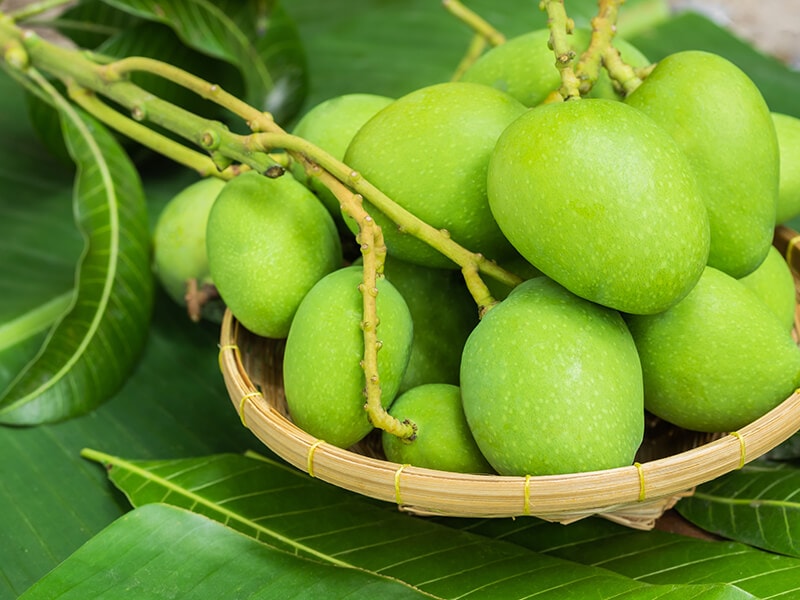
This is an extremely important step, as even the best storing conditions can’t save a bad quality mango. An ideal mango to buy is one that is firm under the touch and gives off a sweet smell near the stem.
Keep in mind that mangoes harvested when they are still green, they can never ripen fully, and usually have soft flesh and green skin. If you only like to eat ripe mango, better avoid these.
Washing & Storing
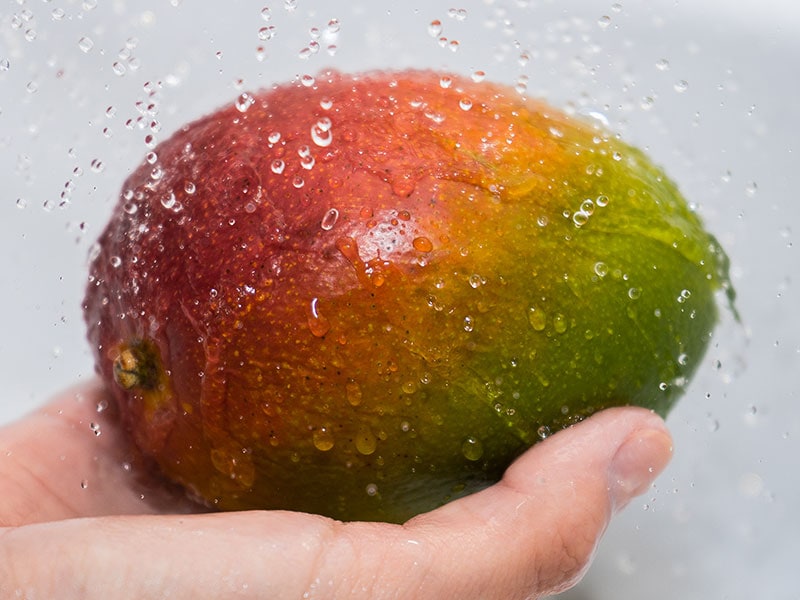
Once you have brought your mango home, the first step is to clean it properly. Here are the steps:
- Run the fruit through tap water to get rid of the remaining dirt and sap on the skin.
- Soak it in salt water for a few minutes
- Use a soft cloth to wipe the stem
- Check your mango at least ONCE a day
Fastening The Ripening Process
Being very impatient and can’t wait to eat your mango? There are several methods to fasten the ripening process:
- Put your mango in a sealed paper bag at room temperature. To further quicken the process, you can also add avocado or tomato inside that bag.
- Put your mango among other ripening fruits
- Keep it at room temperature and out in the sun
You will never have a mango go bad again if you do these things.
Storing Ripe Mango
Ripe mangoes can be stored in the fridge to slow down the decaying process. Usually, a full ripe mango takes 5 to 7 days in the fridge before it goes bad. So make sure to eat your mango before then!
You can also cut or dice your mango into smaller pieces for better consumption, but remember, cut mangoes last for a shorter time in the fridge than a whole fruit, taking 3 to 4 days before getting bad.
How To Peel A Mango
Peeling a mango is easy enough with a bit of practice. First, you need to take out a knife and/ or a peeler. Start by cutting off a small part near the stem, and then run the knife or peeler down the length of the fruit to peel the thin skin away.
Peeling a mango is a walk in the park with these instructions.
How To Cut A Mango
As mango is a tropical fruit, many can be unfamiliar with cutting or eating it properly. Don’t worry, because I’m here to help.
There are many ways to cut a mango. Here are a few:
- In half: Now this one should be easy peasy. Just stand your mango up, and run the knife vertically from top to bottom. Do this on both sides, and then separate the flesh from the pit.
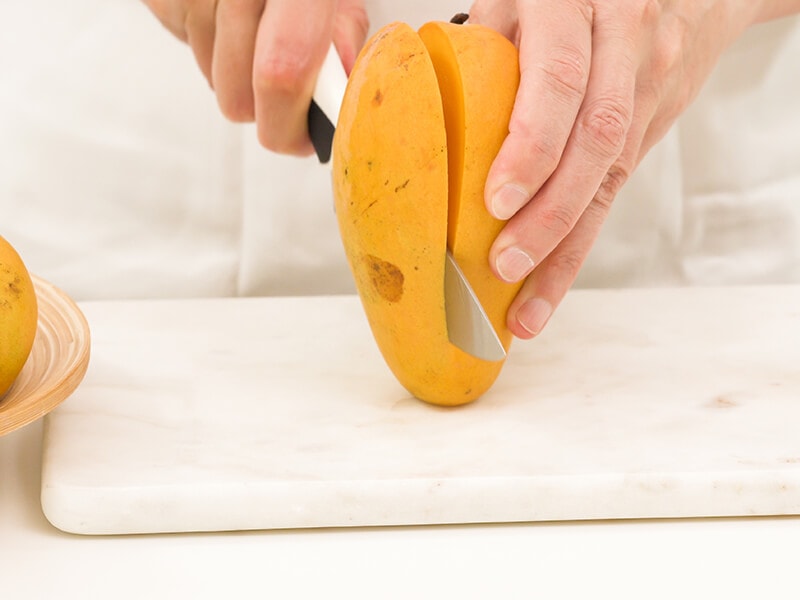
- In slices: First you need to cut your mango in half. Then, cut slices into the parts on a cutting board.
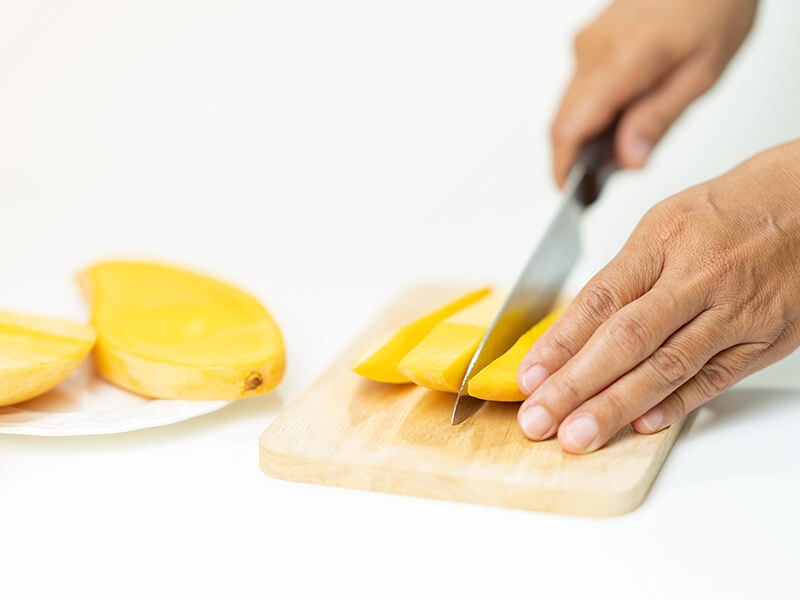
- In cubes: Run the knife down vertically to divide the fruit, and then cut the flesh in a grid pattern. Hold the skin with both hands on two sides and pop the flesh up. Use a knife or your hand to take out the cubes.
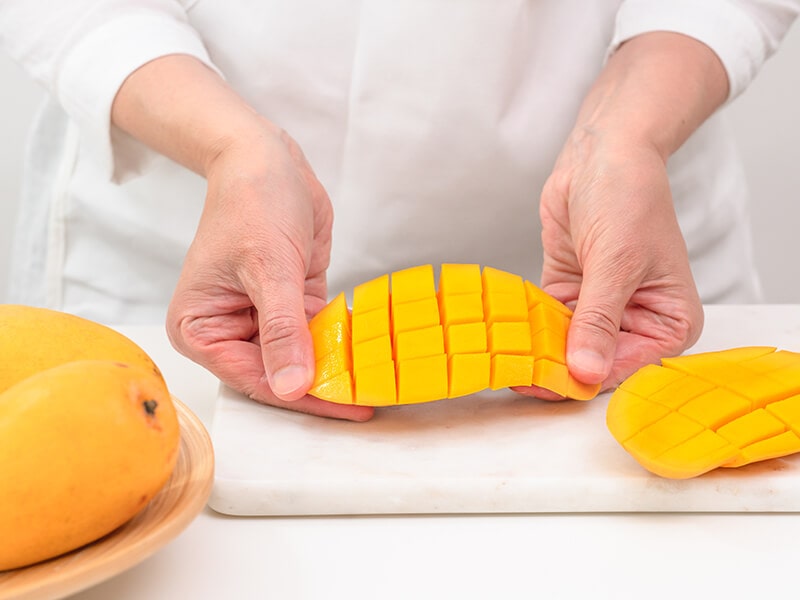
- With a peeler: If you want to make a salad or salsa with mango, then using a peeler is the way to go. After peeling off the skin, run a peeler repeatedly up and down the length of your mango to make thin strips, until you reach the pit.
- With a mango splitter: A mango splitter is a tool made specifically to make cutting mango easier for you. To use it, you just need to push the oval slicer deep into the mango flesh to separate it.
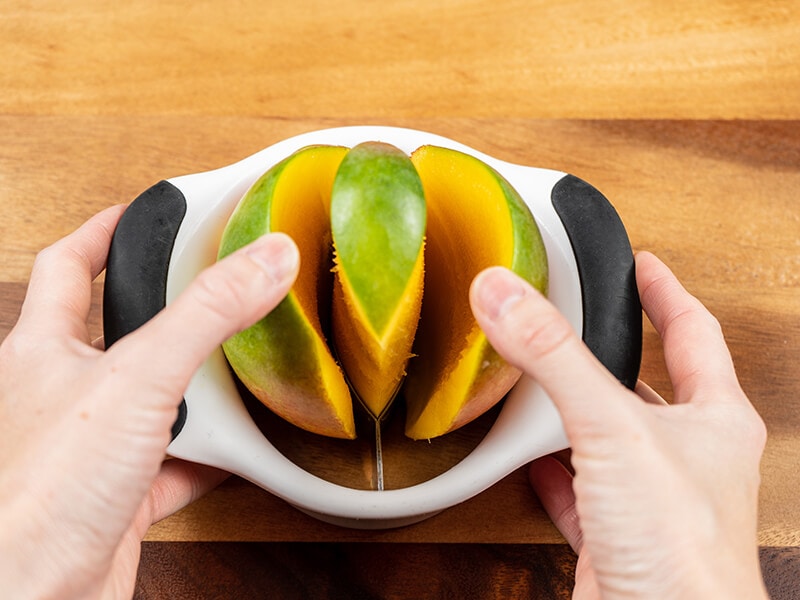
Can I Freeze My Mango?
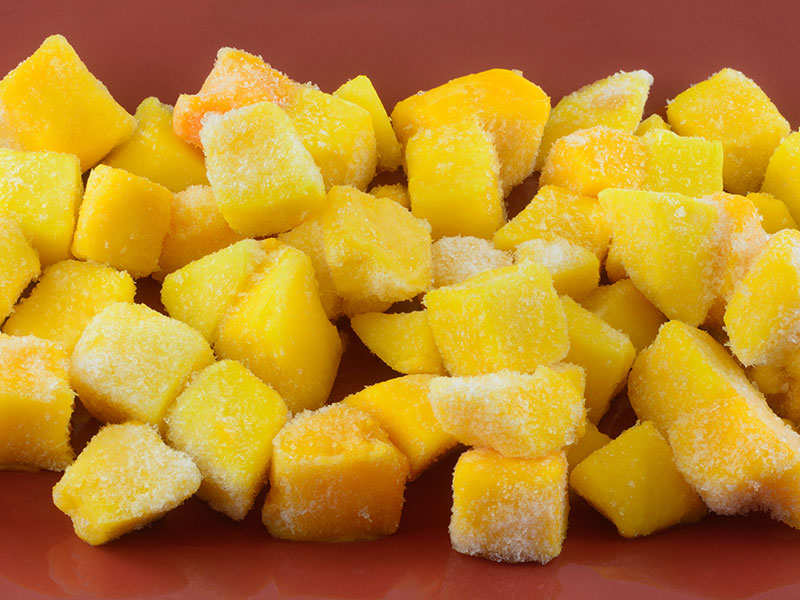
For those who wish to keep their mango for even a long time, freezing the fruit is also an option. Here’s a step-by-step guide on how to do it:
- Wash and peel mango carefully
- Cut mango into the shapes of your liking (slices, cubes, strips, etc.)
- Cover a flat surfaced kitchen tool (baking sheet, dish, chopping board, etc.) with parchment paper. Lay down the cut mango pieces on said surface. Make sure the pieces do not make direct contact with the surface.
- Put the sheet or dish in the freezer, preferably for one night
- Transfer the frozen mango to airtight freezer bags
Freezing mango is no longer difficult after you see this video.
The Many, Many Ways To Enjoy Mango
I’m glad you asked. Mango is a delicacy that can be enjoyed in a variety of dishes, the range of mango sweet treats + (mango desserts) will surprise you. Here I’m gonna show you some of the most delicious and popular ways to eat mango.
Mango Lassi
Mango lassi is a drink made from blended yogurt, water, seasoning, and of course, mango. Depending on your recipe, it can taste salty, sweet, or both, and help indigestion as long as refreshment on a hot summer day.
Mango lassi – A blessing in scorching summer days.
Mango Yogurt
Feeling lazy and can’t be bothered to make a trip to the department store to buy the many ingredients for mango lassi? Well, you are in luck, as there’s a simpler recipe for you to make.
A slightly different version of the mango lassi, mango yogurt is usually made by mixing mango, yogurt, and lime together. All you need to do is blend and stir in a few minutes, and your gourmet mango yogurt is ready to be devoured!
You are missing out a lot if you haven’t tried this amazing mango yogurt recipe.
Mango Sorbet
Yes, mango lassi and mango yogurt are addictive yogurt-based desserts, but what if sometimes you just want some ice cream? Try making mango sorbet instead.
Mango sorbet manages to preserve the sweetness of mango, as well as adding a tinge of sourness and coolness to it.
A cup of mango sorbet a day can keep all sadness away.
Mango Salsa
Not a fan of desserts? How about having a go at mango salsa? Refreshing, juicy, and exciting, mango salsa is a versatile dish that can be eaten alone as a salad, or served along with your favorite seafood or tortilla chips.
Mango salsa is usually made of shredded or cut ripe mango, along with avocado, jalapeno, cilantro, lime juice, and other ingredients to the cook’s liking. These ingredients give the salsa a deep, rich, and simple yet layered taste.
Here’s how to make the most amazing salsa you will ever taste.
Mango Salad
Salads can be boring, but they also can be fun if you are creative. When you are feeling adventurous with your salad, try making this delightful dish.
Mango salad recipes can vary depending on the region, from Vietnamese, Thai, to the Mediterranean, each with its own unique flavor. So let’s grab your favorite vegetables, and seasonings, and start cooking.
Mango salad is the best salad if you do this correctly.
FAQs
Eating mango can be tricky, but I think you and I can agree that the experience is definitely worth the effort. Here’s some extra information that you might want to take note of, as these are some of the most frequently asked questions.
Preserving Mango Is No Longer A Headache
Mango is often called the king of fruit with its rich taste and tropical aroma. However, such tastiness can turn into surprising nastiness if you let it rot. Keep in mind that it all starts with buying the right type of mango, and everything else goes from there.
And that’s a wrap of everything you need to know about the world of mango. Remember to follow all of my tips to save yourself a lot of money and effort, and share them with friends who might need them. If you have any useful tips, don’t hesitate to share them with other readers as well!
References
- Mango Varieties & Availability. Mango.org. (2022).
- On the counter or in the fridge? Here’s the best place to store summer fruit. NBC News. (2022).

